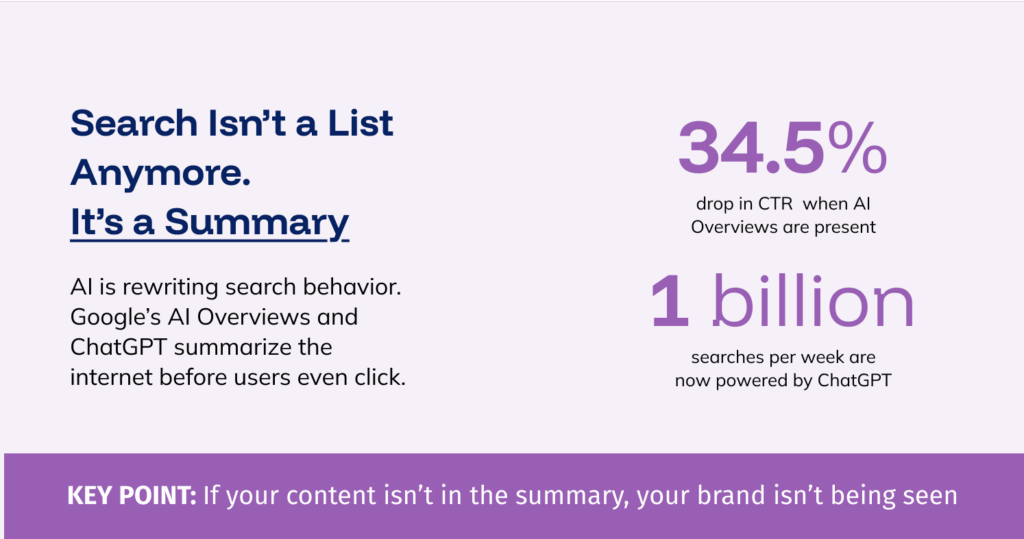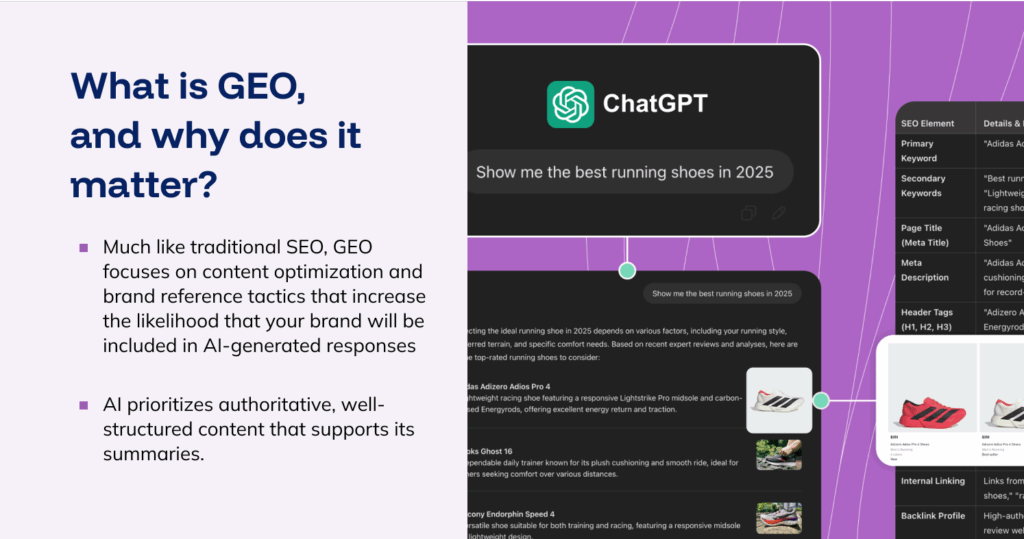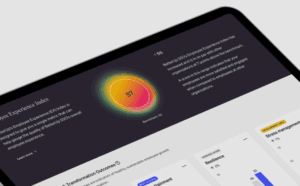Home / Blog / Want to Show Up in Google AI and ChatGPT? Here’s How to Track It
AI Content Marketing digital marketing Go Fish Digital Integrated Marketing Strategy Search SearchSuggestions seo
Want to Show Up in Google AI and ChatGPT? Here’s How to Track It
Published: August 05, 2025• Updated: August 05, 2025
Share on LinkedIn Share on Twitter Share on Facebook Click to print Click to copy url

Contents Overview
Search doesn’t look like it used to, and it’s not going back.
Platforms like ChatGPT, Google AI Overviews, and Perplexity now surface direct answers instead of link lists. As a result, click-through rates are dropping. In fact, internal analysis at Go Fish Digital shows a 34 percent decline in traffic when AI Overviews are triggered, even for pages that rank well.

“Search is not just a list of links anymore. Those days are gone and likely never coming back,” said Chris Long, VP of Marketing at Go Fish Digital.
This shift in behavior is changing how marketers think about SEO. Brands have to rethink what it means to show up. That includes how they rank, how they track, and how they structure their presence in a search experience that favors summaries over traditional results.
AI Picks Winners Differently
Traditional SEO strategies still matter, but they’re no longer enough on their own. AI search tools focus less on keywords and more on meaning. Large language models are trained to identify clear, complete, and well-structured content that matches a user’s intent, not just optimized phrases.
“These models aren’t just crawling pages. They’re trying to understand a concept and find the clearest, most complete explanation,” Chris explained.
Content that’s cleanly structured with headers, summaries, and FAQs performs better in this environment. So do pages that offer full-topic coverage, not just quick hits. Even lower-ranking URLs can show up in Google AI Overviews if they contain strong, well-aligned passages.
“Sometimes we see articles on page two or three get pulled into AI Overviews. Not because they rank high, but because they nail the answer,” Chris added.
ChatGPT and Google AI Overviews Aren’t the Same
While both platforms serve AI-generated summaries, they don’t pull from the same sources. ChatGPT will often trigger a live search when its internal model lacks enough data, meaning your SEO efforts still matter in shaping real-time answers, especially if your content semantically aligns with how ChatGPT responds to prompts.
Chris pointed out a recurring pattern: “ChatGPT will run a live search when its model doesn’t have enough. If your content lines up with the prompt, you’ve got a shot at being pulled into the answer.”
For product-related queries, ChatGPT often adds the word “reviews” behind the scenes. If your pages lean too heavily into sales copy and skip review-style content, you’re likely missing out.
Google’s AI Overviews operate on indexed content, but traditional rankings aren’t the only factor. Well-written passages that answer a query clearly can be pulled into Overviews, even if the page itself is buried on page two or three.
What Gets You Into the Answer Box
Visibility in AI search depends on relevance, authority, and format.
That means your content needs to be structured for easy scanning, organized by subtopics, and deep enough to satisfy the model’s understanding of the query. But what happens off your site matters just as much.
AI models also look at how often your brand shows up across the web. Third-party validation, mentions in review sites, Reddit threads, and trusted publications, signals to search engines that your brand is credible and contextually relevant. Consistent citations alongside your competitors help reinforce that connection.

Kalina MacKay, SVP of Owned Media, noted that digital PR is now a search tactic. “If we’ve gotten a lot of media coverage with that associated phrase from highly authoritative sites, we’re more likely to get pulled into AI responses.”
She also emphasized the influence of major publishers on ChatGPT’s responses. “OpenAI has licensing deals with a ton of major publishers. So if you get mentioned in Good Housekeeping or Vanity Fair, even without a backlink, that content can influence what ChatGPT includes.”
How to Track AI Search Visibility
This new reality means your measurement strategy has to evolve too. It’s no longer enough to look at rankings and clicks. To really understand AI visibility, you need to track whether your brand is showing up in the answers themselves.
Here are a few ways to start:
- Test prompts manually. Use ChatGPT with browsing enabled and try queries your customers might ask. Are you in the response? Who is?
- Use AI visibility tools. A growing set of SEO tools now tracks when your content appears in Google AI Overviews and other summary results. Look for tools that can analyze at the passage level.
- Track co-citations. Platforms like BuzzSumo or Ahrefs can help you identify where your brand is mentioned in relation to competitors, even if you’re not directly linked.
- Monitor impression share. Some tools are starting to show how often your content is included in AI-generated results, even without a click. That’s the new visibility metric.
“Ranking doesn’t mean what it used to,” Chris said. “You need to know if you’re being cited, summarized, or skipped.”
What to Do Right Now
If you want to show up in AI-powered search, here’s where to focus next:
- Audit your content. Compare what’s live on your site to what appears in Google AI Overviews and ChatGPT responses. Look for missing formats, structures, or questions you haven’t answered clearly.
- Add structure. Use headers, bulleted lists, FAQs, and summaries. Make your content skimmable and easy for models to parse.
- Build clusters. Don’t rely on one post per topic. Create multiple content types, product pages, comparison guides, blog articles, and explainer videos, that show depth and consistency.
- Get mentioned. Collaborate with PR and SEO teams to earn brand citations in high-authority outlets. Use phrasing that helps AI models understand your category and expertise.
Kalina summed it up clearly: “We’re not just optimizing for clicks anymore. We’re optimizing to be included in the answer itself.”
Want to know where your brand stands in AI search?
Go Fish offers an AI Visibility Audit that shows how often your brand is cited in Google AI Overviews, ChatGPT, and other generative search platforms. You’ll get insights, benchmarks, and a strategy to start showing up more.
About Kimberly Anderson-Mutch
MORE TO EXPLORE
Related Insights
More advice and inspiration from our blog
Top Generative Engine Optimization (GEO) Agencies and Thought Leaders
Generative Engine Optimization (GEO) — sometimes referred to as AEO (Answer...
Patrick Algrim| August 08, 2025
Use Screaming Frog Custom JavaScript to Pull Google Search Results for Your Pages Target Topics
One of the most efficient ways to understand how Google might...
Dan Hinckley| August 06, 2025
Why Clicks Don’t Count: What the Best CMOs Are Tracking Now
Clicks don’t tell the whole story anymore. AI is reshaping how...
Kimberly Anderson-Mutch| August 05, 2025





